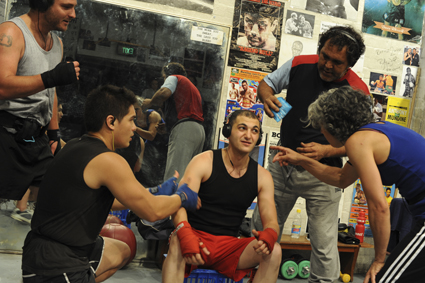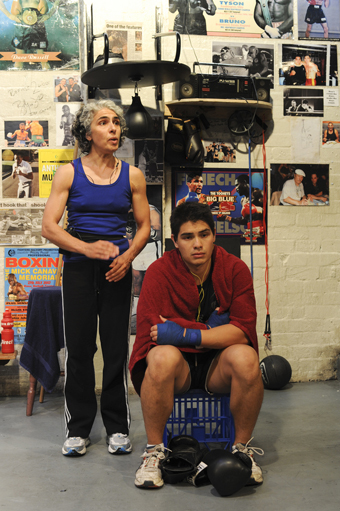Hands up, head down!
Fiona Carter: Roslyn Oades, I'm Your Man

I’m Your Man
photo Heidrun Löhr
I’m Your Man
Noise, action, gym equipment and boxing paraphernalia clutter the stage. A trainer barks commands and encouragement to his boxer as they spar. The audience has stepped straight into the guts of a boxing gym; all that is missing is the sticky, musky odour of stale sweat.
We are not eased into this performance gently. The bell rings and the characters come out fighting, each clang marking a rapid segue to the next character and his story. I felt as a boxer must when he enters the ring to face his opponent.
The actors, each wearing headphones and an iPod, faithfully mimic recordings of the voices of actual boxers. All the imperfections of speech remain, including stutters, tics, stumbles and slurs. The quickfire delivery is at times disconcerting, like a boxer’s swiftly thrown punches: BAM, BAM, BAM. No hint of the carefully measured pace of traditional theatrical monologue.
The mimicry aptly reveals the differing characteristics of the boxers, from the manic energy of one to the disturbingly sedate violence of another, to the cocksure egotism or the concerns of the ‘King’ who wants to make sure his court of supporters enjoys the same spoils of victory as himself. “Feel like the King, but being the King in the right way, you know?”

Katia Molino, John Shirmpton, I’m Your Man
photo Heidrun Löhr 2007
Katia Molino, John Shirmpton, I’m Your Man
Interruptions sometimes lead dialogue away from the central theme of boxing to reveal a deeper dimension. An aside to one of the “ladies that works here” bumps the dialogue off track as the boxer reflects, “boy and girl get together to relax their body. Sometimes relax their body too much, you know?”
While I’m Your Man is heavily dependent on dialogue, at times visual effects are used to reinforce a theme. The competitive nature of boxers is displayed as two gym mates skip together in training. Each notices the other and the tempo and skill level of tricks increase as the two try to outdo each other with displays of speed and prowess.
Music and soundscapes are used sparingly, highlighting particular moments, building the momentum towards a climax or intensifying the emotion in a boxer’s words. One poignantly reflects upon the accidental death of his sparring partner and the punch he threw that ended his life. The boxer approaches his next fight in homage to the dead man, reliving the tragic event, the light darkening and the music moaning and groaning in unsettling accompaniment.
Win or lose. Beat or be beaten. “Probably if you don’t smash ’em, they’re gonna smash you.”Clearly a driving force for any boxer, this theme was realised in different ways time and again.
In a vignette focused on a winner and a loser, the defeated boxer sits quietly, shrouded in a towel. His manager stands behind. With his Thai accent the manager stumbles over the pronunciation of “Cinderella Man” and the audience giggles in response. We are thrown to the winning boxer whose frenetic energy provides an extreme counterpoint to the stasis of the loser. While the losing manager attempts to explain the plight of his boxer, the winner is busy handing out autographed pictures of himself to the audience. The loser fades into the background. The winner and his entourage noisily head off stage for “Maccas,” crashing about full of adrenalin and masculine bravado.
While the boxers often ooze ‘piss and vinegar’ we are also reminded of the vulnerability of these seemingly hard men. At 84 years of age a tired man honestly reveals a struggle with alcohol and the many back operations that have left him in pain. I’m Your Man is the third work in a trilogy exploring courage. Despite all the shouting about guts for glory there is no doubt that in the boxing world courage carries a cost.
“Hands up, head down.” As a boxer reminds us, this is good advice not only for boxing but also for life. I couldn’t help but think it to be good advice for anyone in the audience for I’m Your Man.






